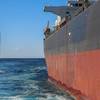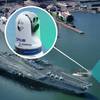NAVSEA Eliminates CFCs Onboard Carriers
All U.S. Navy aircraft carriers are now chlorofluorocarbon (CFC)-free. Naval Sea Systems Command (NAVSEA)’s Shipboard Ozone Depleting Substances (ODS) Elimination Program marked a major environmental milestone April 2 with the elimination of the final ozone depleting CFC refrigerants aboard the aircraft carrier USS Carl Vinson (CVN 70).
“NAVSEA is eliminating these CFC refrigerants because they deplete the earth’s protective ozone layer which screens out potentially harmful radiation from the sun,” said Gregory Toms, NAVSEA ODS elimination program manager.
NAVSEA strives to be a good steward of the environment while building the future Navy and sustaining the current fleet. Currently Carl Vinson is nearing completion of a Refueling Complex Overhaul. When the ship returns to the fleet later this year, it will have 10 air-conditioning plants and five refrigeration plants that have been converted from CFC refrigerants to non-ozone depleting hydrofluorocarbon (HFC) refrigerants.
Carl Vinson joins the other eight CVNs built prior to USS Ronald Reagan (CVN 76) that have now all been converted to ozone-friendly refrigerants. Starting with Ronald Reagan, all new aircraft carriers are built without CFC refrigerants.
“The primary purpose of these CVN refrigerant conversions was to eliminate the nearly one million pounds of CFC refrigerants that would have otherwise been emitted to the atmosphere over the remaining ships’ service years,” said Toms.
In addition to being ozone depleting substances, these refrigerants are also potent greenhouse gases. Although the HFC refrigerants replacing the CFCs are also greenhouse gases, they have lower global warming potentials which drastically reduce their impact on the earth’s climate. The reduced climate impact from the CVN 70 refrigerant conversions alone are equivalent to eliminating the greenhouse gas emissions from the burning of more than 38 railcars of coal every year. When all of the CVN refrigerant conversions are accounted for, the annual emission reductions are equivalent to 325 railcars of coal.
The conversions also have several other important operational advantages including reduced acoustic signature, increased cooling capacity in areas of the world with high seawater temperatures, decreased logistics support and training requirements, simplified troubleshooting procedures, and increased reliability. These conversions also support energy and environmental goals to reduce greenhouse gas emissions and increase energy efficiency.
NAVSEA researchers and engineers also worked closely with the original equipment manufacturer to improve the energy efficiency of the air-conditioning plants as part of the conversion process. Using state of the art electronic control systems and compressor improvements, the converted HFC plants are up to 15% more energy efficient than they were prior to the conversions.
Another major milestone will be reached in 2010 when all shipboard refrigeration plant conversions are completed. Because the air-conditioning conversions must be completed during major ship maintenance availabilities these conversions are scheduled to continue through 2017.
(Source: Naval Sea Systems Command Office)












